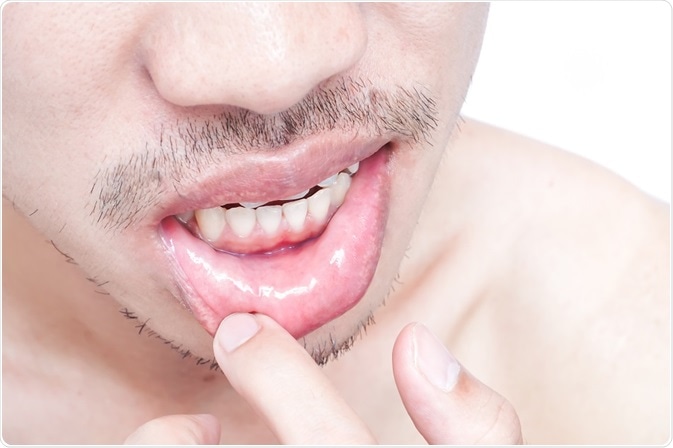While both angular cheilitis and herpes simplex type 1 may be responsible for inflammation at the corners of the mouth, the two are very different conditions with quite different etiologies. It is therefore necessary to distinguish between them so that appropriate treatment may be given.

Credit: MRAORAOR/ Shutterstock.com
Why is angular cheilitis mistaken for herpes simplex around the mouth? This may be because both cause red painful lesions near the lip corners. One or both sides may be involved, and the lesion may take 2-3 weeks to heal.
Differences
Origin
Angular cheilitis begins as a red dry patch at the corners of the lips. One or both sides may be affected. It is associated with discomfort, cracking of the skin to form the characteristic fissures of the skin, bleeding and ulceration. The skin at the angles takes on a scaly appearance. If left untreated, the skin breaks down to form ulcers and it becomes painful to open the mouth.
The cracks may also bleed with each mouth movement as the edges alternately adhere and rip apart. The chief sensation is of dryness, pain and burning. This is easily tested by applying pressure to the lesions, when the identical sensation is elicited.
Herpes simplex type 1, which is termed herpes labialis when it occurs around the mouth, typically starts as a pruritic sensation which quickly becomes painful in about 12-24 hours. The next step is the rapid development of a group or cluster of small and painful vesicles containing clear fluid. These are lined up roughly along the vermilion border of the lips.
They change in appearance from day to day. Thus, they first discharge clear fluid, then scab for a few days to form a crust, and finally start to heal in about a couple of days. The whole process may last for one to two weeks. The eruption is almost always on only one side of the mouth.
Affected population
Angular cheilitis, also called perleche, is more often seen in edentulous older people as the upper lip tends to hang down in the absence of support by teeth. This overhanging flap traps moisture in the corners of the mouth, predisposing to the formation of candidial overgrowth. This in turn translates into a high chance of angular cheilitis and secondary infection.
Poorly fitted dentures are another common risk factor. Other predisposing factors include inflammatory bowel disorders (ulcerative colitis or Crohn’s disease), post-antibiotic therapy, allergic or atopic conditions, and nutritional deficiencies (lack of iron, zinc or riboflavin).
Very small children who dribble saliva a lot of the time, or who always use pacifiers, also are more prone to angular cheilitis.
However, patients with herpes labialis are usually young, and the lesions develop as a secondary eruption, the primary eruption within the oral cavity having passed without notice. In fact, most primary oral herpetic lesions are asymptomatic.
The recurrent herpetic outbreak on the face is symptomatic, and may follow exposure to ultraviolet light (as in tanning), trauma, tiredness or other stressors. They are also called cold sores and result from a reactivation of the latent herpes simplex viruses ‘resting’ within a clump of nerve cells on the face, called the trigeminal ganglion.
Treatment
Herpes labialis is treated with an antiviral ointment or pills, while angular cheilitis requires effective and adequate topical anti-fungal and anti-bacterial treatment. Hydrocortisone 1% creams are also used in several cases of angular cheilitis. Specific causes must be addressed as well.
A thick emollient or barrier ointment such as zinc oxide is also recommended between anti-infective applications to prevent other organisms from gaining entry to the inflamed site. The recurrence rate may be as high as 80%.
Sources
- https://www.ncbi.nlm.nih.gov/pmc/articles/PMC1949217/
- https://www.ncbi.nlm.nih.gov/pmc/articles/PMC4282904/
- http://www.aafp.org/afp/2007/0215/p501.html
Further Reading
- All Angular Cheilitis Content
- Angular Cheilitis causes and treatments
- What is Angular Cheilitis?
- All Herpes Simplex Content
- What is Herpes Simplex?
Last Updated: May 27, 2019

Written by
Dr. Liji Thomas
Dr. Liji Thomas is an OB-GYN, who graduated from the Government Medical College, University of Calicut, Kerala, in 2001. Liji practiced as a full-time consultant in obstetrics/gynecology in a private hospital for a few years following her graduation. She has counseled hundreds of patients facing issues from pregnancy-related problems and infertility, and has been in charge of over 2,000 deliveries, striving always to achieve a normal delivery rather than operative.
Source: Read Full Article



